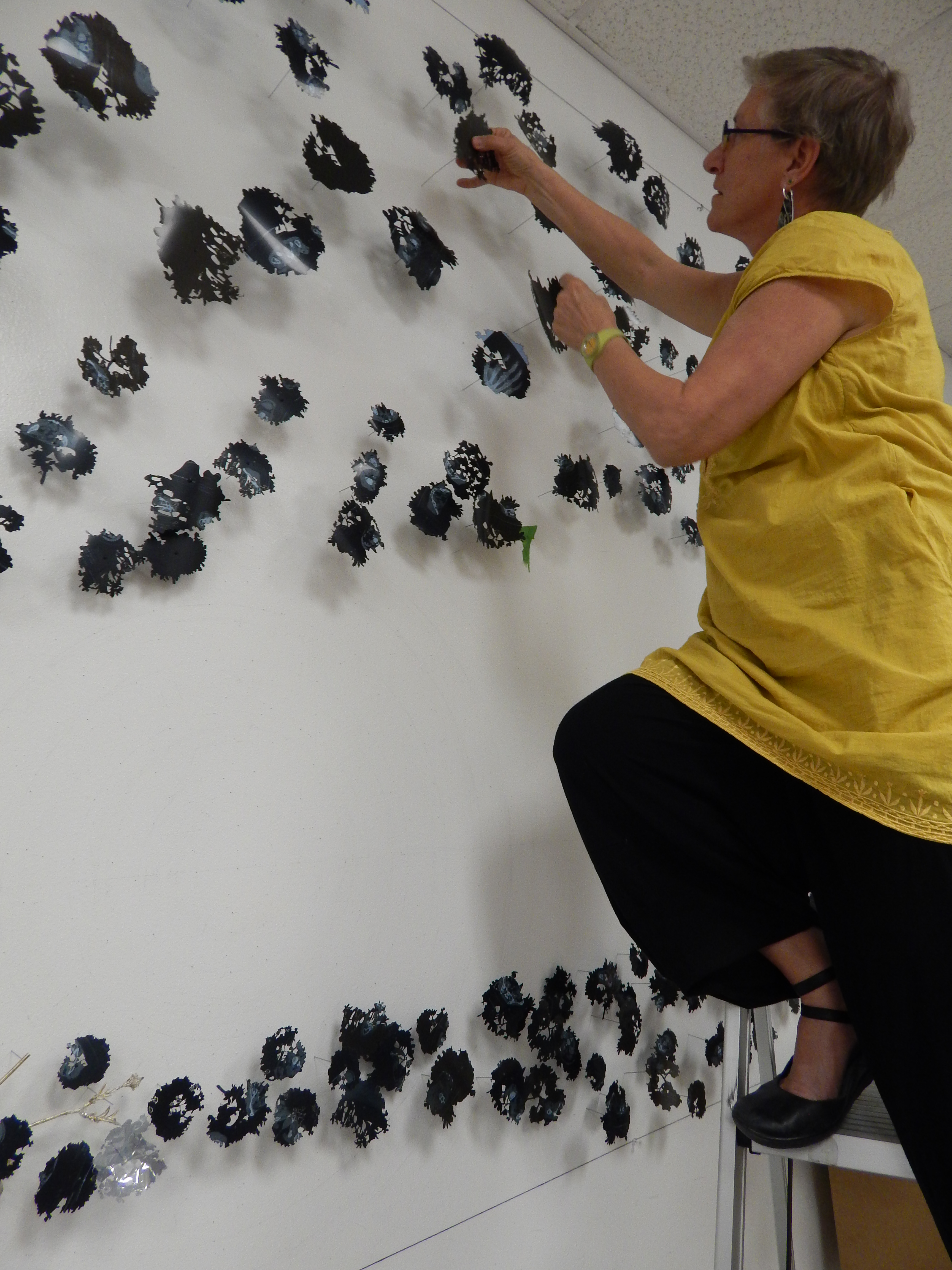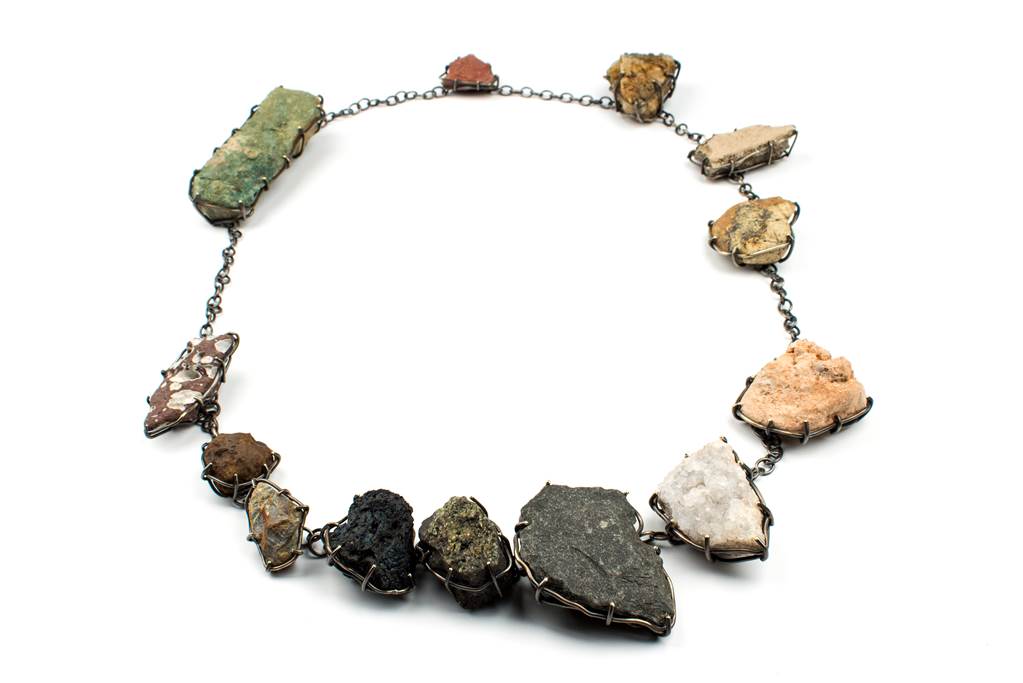NMSU professors among 300 artists in historic exhibit about New Mexico Jewelry


The jewelry of two New Mexico State University art professors will be on display in a first-of-its-kind exhibition opening at the Albuquerque Museum in June.
“American Jewelry from New Mexico” opens Saturday, June 2 and runs through Oct. 14. The show represents nearly 2,500 years of jewelry history and includes some 300 artists from five cultures.
A book published by the Museum of New Mexico Press complements the exhibition.
Julia Barello, professor and head of the Department of Art in NMSU’s College of Arts and Sciences, while not a native New Mexican, has been a practitioner of art in the state for more than 25 years. “The premise of the show is highlighting the arc of jewelry making production in the state of New Mexico from the ancient historical to contemporary.”
The NMSU professors’ jewelry rounds out the contemporary timeline of history.
Barello claims the largest piece in the show – a 30-foot-long, 15-foot high wall-composition constructed of hundreds of shapes of MRI film (magnetic resonance imaging film) cut in the shape of hydrangea flowers. Strewn among the MRI flowers, sterling silver jewelry cast from original hydrangea plants are attached to the wall.
“The way my work fits into this is people will look at the wall and they won’t recognize it as jewelry initially,” Barello said. “They’ll have to work to see there are wearable elements of body adornment incorporated into the wall composition. This approach re-contextualizes jewelry from the top of a pedestal or a jewelry box to part of a huge wall installation. It shifts around our perceptions of what jewelry is or should be.”
Motoko Furuhashi, associate professor of art, fabricated a necklace of sterling silver, with mounted stones collected from across the state: Red River, Taos, Hatch, Los Alamos, Gila, Silver City, Aiden, Twin Lakes, Afton and Dona Ana. The necklace serves as a commemoration and record of a journey around the state.
“I was really interested in geological formations like soils and rich colors,” Furuhashi said. “I specifically picked stones from locations that are visually and aesthetically different from each other. Some of them are coppery green or crystal-like quartz and some of them are really rich red.
“New Mexico has so much history, deep in the culture. It makes me think of how people living decades or centuries ago were touching things I’m touching. It makes me think of what was happening historically. How the people shifted, how the culture shifted and now they’re part of the history.”
The history of jewelry making in New Mexico has been too big to tackle – until now.
“This show will exhibit unique jewels running the gamut from ancient through modern interpretations of culture and region,” according to Phil Poirier, a Taos-area goldsmith and master gem cutter. “This is probably the first time an exhibit of this size and diversity has ever been curated in the state.”
The collection focuses on what unifies, not what segments, jewelry making in New Mexico, curator Andrew Connors said. The show features about 300 objects, only one masterwork by an artist or creative team, representing a unique creative moment in time.
“Telling all these diverse stories as one, focused on New Mexico, provides a glimpse into the American experience that is needed now more than ever,” argued Connors, curator of art at the museum. Innovation and invention are the heart of creativity, he said, and “New Mexican jewelers have been proving that for 2,418 years at least.”
Soon after Connors started planning the exhibition, he realized the significance of the comprehensive view of an art form that crosses and blends cultures. As curator, he challenged the traditional commercial and scholarly views that have divided Native American jewelry from “high jewelry” represented by American jewelers. “Unfortunately,” he said, “by never telling the stories of these trajectories simultaneously, we have never been able to see the true breadth of artistic achievement in our nation’s creativity.”
Connors’ emphasis on diversity and inclusiveness attracted Maria Samora, a Taos Pueblo jeweler known for her minimalist designs. The featured artist for Santa Fe’s Native Treasures art market over the 2018 Memorial Day weekend, Samora said in an interview before her selection that she is driven both to stay true to her roots and to break down stereotypes.
“I think New Mexico has always had a very distinguished and unique style,” she said. “I believe that people are always being influenced by each other. I see my designs being fueled by my passion to learn and explore technical possibility and new technology,” she said. “We are all connected either consciously or even on a subconscious level.”
For Claire Kahn, a maker of refined bead-crochet jewelry who moved from San Francisco to Pojoaque in 2016, the Albuquerque exhibition celebrates the fresh ideas of artisans “inspired by, rather than derived from, the important examples and history surrounding us.” While many events successfully showcase New Mexico’s rich tradition in fine art, metals, pottery and architecture, she observed, jewelry shows tend to focus on a single culture, era, material or technique.
“For the designer and artist, inspiration can come from numerous sources and often involves a combination and a blurred crossover between them,” Kahn said. “To isolate them does a disservice to both the artist and the viewer.”
The NMSU professors’ work reflects their philosophy as artists and metal smiths.
“Both Motoko and I have been trained in a discipline that looks at the traditions of jewelry making – the techniques of jewelry making,” Barello said. “We look at how we can make meaningful statements with art content. We can say a lot about the human condition by the kind of jewelry we create.”
She said the work of her teaching colleague Furuhashi honors the hands-on experience of collecting and making. “It’s personal and it’s intimate and speaks to her moving through time and space and what someone interacts with through time and space,” Barello said of Furuhashi’s piece. “I really do think our works will be significantly different from other pieces in the show."
Despite the artists’ unanimous praise for diversity in the exhibition, the curator saw early on that his vision of inclusiveness had its limits. Because the scholarship of Native American jewelry is extensive, Connors said, the new collection was unlikely to shed light in that area. However, he noted, the project – involving works by Native American, Hispanic, Asian, African and northern European artists – should inspire all artists to search for influences beyond their territories and traditions.
“This is illustrated so clearly,” Connors said, “in a necklace dating to about 500-450 B.C.E. in which white shell, hand carried from the Pacific Ocean, was strung on yucca fiber cordage to create an entirely new aesthetic, mixing materials that had never been combined before.”
“The greatest imagination is found at the place where cultures meet. The cacophony of aesthetic voices reflects perfectly the diversity of American heritage itself.”


